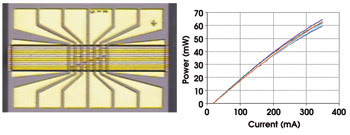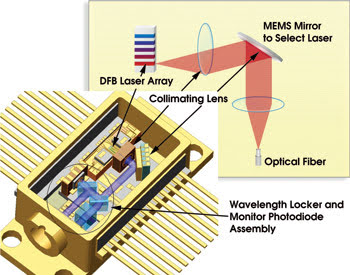Bardia Pezeshki, Santur Corp.
The manufacturing yield of single-mode lasers for modern fiber optic communications systems is surprisingly low, typically 50 percent or less, a problem that also can extend to tunable lasers.
The source in a fiber optic communications system must have a high degree of spectral purity because fiber dispersion would elongate a spectrally broad pulse and lead to signal distortion at the receiver. Of the many lasers used in today’s fiber optic telecommunications market, those capable of the longest reach in single-mode fiber emit at around 1.55 μm. These are typically single-frequency distributed feedback lasers.
One issue with distributed feedback lasers is that devices with both high power and efficiency often have an intrinsically low yield, which increases cost. Such lasers generally have a high-reflectivity coating on the rear side and an antireflection coating on the front facet, forcing all the light to exit the front facet for maximum efficiency. With these devices, cleave and cavity length cannot be controlled to a fraction of the grating pitch (about 0.25 μm in long-wavelength lasers), so yield is intrinsically poor. Some lasers have the right cleave position and therefore lase in a single mode, while others from the same batch have an inappropriate cleave position and lase in two modes. Manufacturers must carefully test every laser, and they typically throw out up to 50 percent of the laser chips.
Of the various ways to increase the yield, most generally sacrifice power and efficiency. For example, using a precise phase shift in the buried grating, one can force the laser into always emitting a single mode without the high reflector on the back facet — but this wastes light out of the back of the laser. This type of device is generally called an index-coupled phase-shifted distributed feedback laser.
Alternatively, instead of using an index grating, one can vary the gain of the quantum wells in the laser to produce the same effect. One way to do this is by etching away the quantum wells so that there are fewer in some areas and more in others. The gain or loss changes as a function of position. Devices based on this strategy are called complex-coupled because gain can be thought of as the complex part of the refractive index. They also fundamentally lase in a single mode but require antireflection coating at the back of the laser, which can decrease efficiency.
One technique that helps tremendously with cost pressures of both single- and multiwavelength systems involves integration. Whether one fabricates a single transistor or multiple devices in a process, the cost is roughly the same. All of the transistors are made simultaneously during the fabrication process, and generally all that affects cost is chip size.
The same is true of distributed feedback lasers. There is little increase in complexity when fabricating multiple lasers at the same time on the laser chip, and because of the very small stripe width of the laser and minimum die size required for handling, there is no substantial increase in real estate.
An example is a buried-heterostructure laser array from Santur Corp. of Fremont, Calif., that integrates 12 lasers on a 0.75 × 0.5-mm die. The array can be made highly uniform in some ways, such as the light current characteristics, but varied in others, such as wavelength. One can control the wavelength of each laser precisely in the array by changing the grating pitch and phase of each element (Figure 1). The slight increase in process complexity compared with a single-bar laser is reportedly more than compensated for by the enhanced yield.

Figure 1. In this 12-element distributed feedback laser array, only the laser with the most appropriate wavelength and spectral purity is used, producing a higher yield than chips with only one laser on the die.
In single-wavelength systems, where wavelength is not as important as spectral purity, one can vary the phase of the grating between the different lasers such that at least one laser in the array oscillates in a single mode. The lasers can be made with a high reflector in the back to maximize output power. Once the chip is cleaved, the devices are measured, and the laser with the highest spectral purity is used. With 12 randomly cleaved lasers, the odds are that at least one of them will have the correct phasing between the grating and the highly reflecting cleave.
In multiwavelength applications, the grating pitch can be adjusted in the array to allow selecting the best laser based on spectral purity and wavelength. In this case, the grating phase and pitch are varied to provide a distribution of characteristics in each array. The most desirable device is then bonded and used, which helps increase yield.
Tunable lasers
A more complex use of laser arrays is in tunable lasers, where the lasing wavelength can be electronically controlled after the packaging process is completed. There are many ways of making tunable lasers, with some companies using a bulk external-cavity approach, others a more complex waveguide structure.
The goal of tunable lasers is twofold. First, they eliminate the cost of inventory for multiple parts and spares because any laser can tune to operate in a required channel. Also, the wavelength of the laser can be changed in operation to reconfigure the system, allowing the optical signals to be varied and routed in different ways to compensate for changing demand. Compensating for load this way helps reduce overall system cost.
Distributed feedback arrays also can be low-cost, high-performance tunable lasers. Each laser can be tuned over a narrow band by changing the temperature setting on the thermoelectric cooler in the laser package. By having an array of temperature-tuned lasers, one can tune over the entire band. Depending on the required wavelength, one array element at a time is activated and tuned to precisely lock to the wavelength grid. The challenge here is how to combine all the laser elements into a single fiber.
The traditional method of coupling from a laser array into a fiber has been an integrated star coupler. Unfortunately, such couplers suffer from high loss, and additional components such as semiconductor optical amplifiers are required to boost the power. Santur’s alternative approach employs a simple microelectromechanical system (MEMS) switch to couple the right laser into the fiber with virtually no optical loss. This allows fabricating a simple tunable laser with performance virtually identical to that of standard distributed feedback devices.
The chip is then a simple array of phase-shifted distributed feedback lasers, and the MEMS switch is a mirror in the focal plane of a collimating lens. This mirror compensates for the different position of each laser so that all the beams reflect from the mirror in the same direction. The only loss beyond that of a single laser system, caused by aberrations in the lens and less-than-perfect reflectivity of the mirror, is relatively minor (Figure 2).

Figure 2. In a tunable laser based on an array of temperature-tuned distributed feedback lasers, one element of the array is activated — depending on thewavelength that is required — and fine-tuned thermally to lock onto a 25-GHz grid. A MEMS mirror in the focal plane of the collimating lens directs the light to the output.
The ability to make arrays of lasers produces many advantages for telecommunications. It reduces cost by raising the yield, with multiple devices to choose from on a die. By activating one element at a time, the array’s wavelength can be varied to allow simple tunable systems that can reconfigure the network and eliminate the cost of inventory and spares.
Meet the author
Bardia Pezeshki is chief technical officer for Santur Corp. in Fremont, Calif.; e-mail: [email protected].